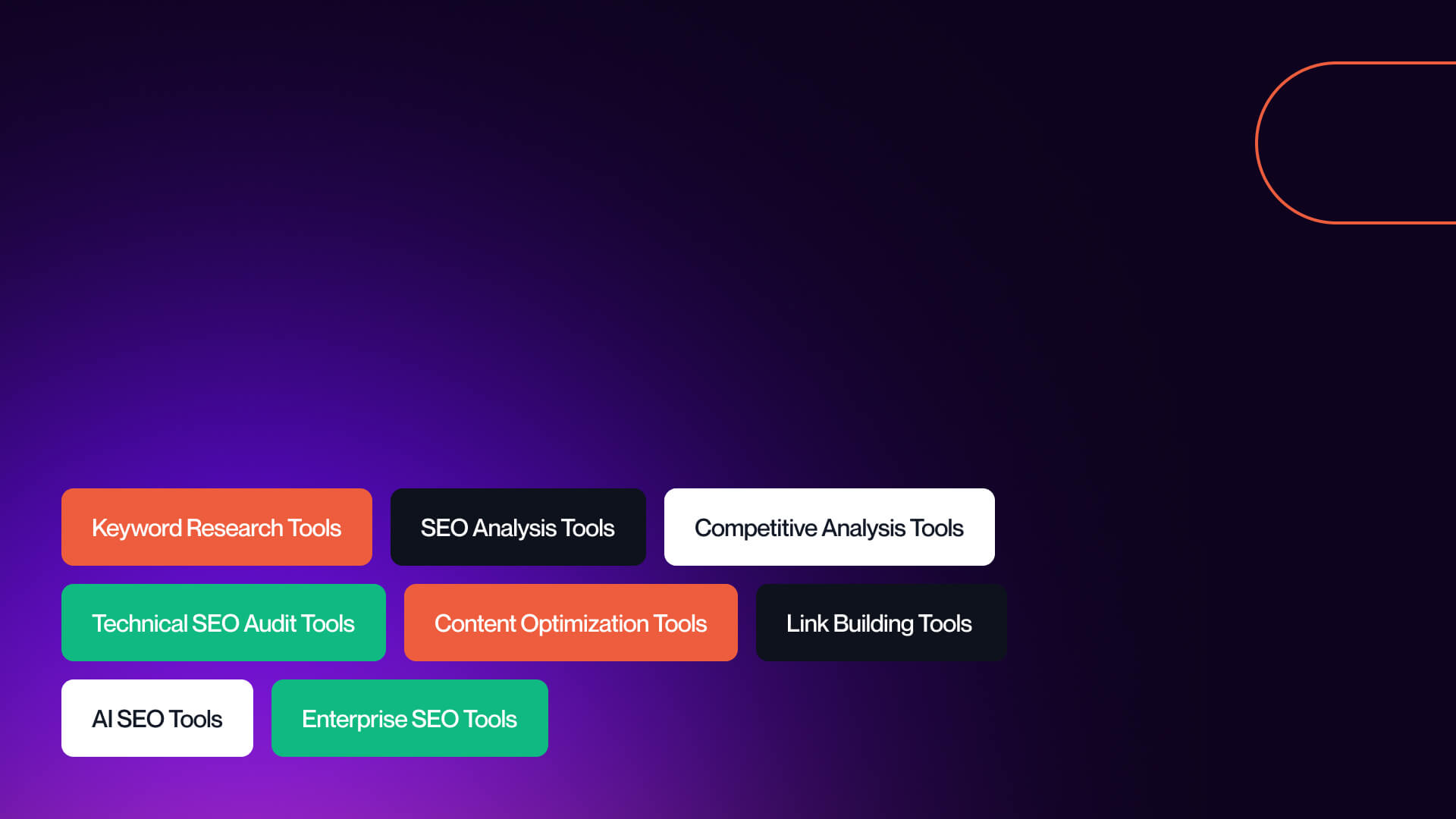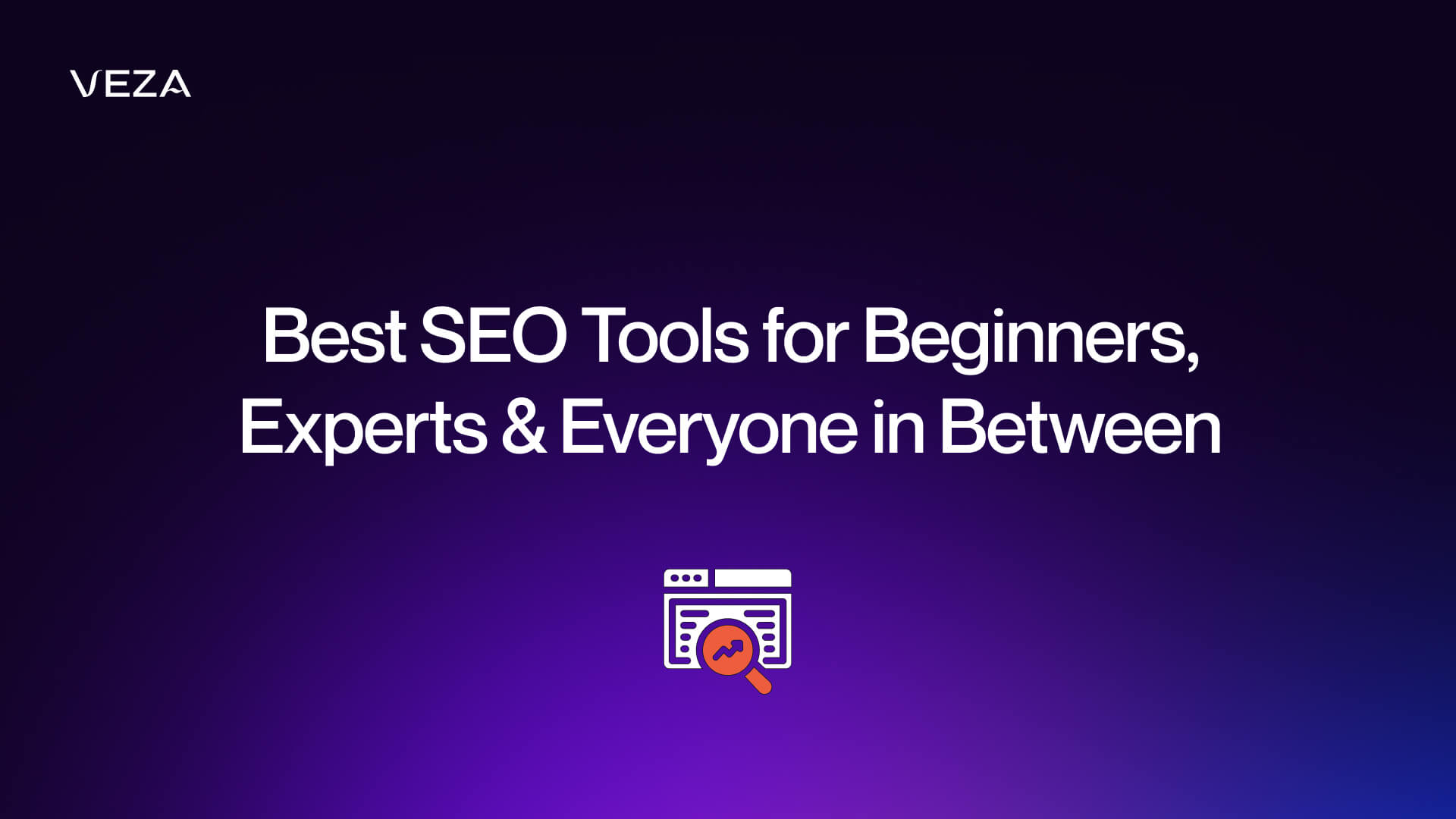Marketers know SEO is still king (or queen!), and picking the right SEO tools can be the difference between hitting the top spot on the first page of SERPs or barely making it into the top ten - or not showing up at all!
This guide offers marketers a clear overview of the best SEO tools in 2025 to boost their marketing strategies.
Whether you're a seasoned SEO professional or just starting in search engine optimization, you will find the essential tools you need for success.
We'll explore various categories of SEO tools, including keyword research, competitive analysis, technical SEO audits, and content optimization, giving you a comprehensive understanding of the resources available.
The Essential Categories of SEO Tools

To effectively tackle your SEO, you need a diverse toolkit. Here are some key categories of seo tools marketers should be familiar with:
Keyword Research Tools

Understanding what your audience is searching for is fundamental. Tools in this category help you discover relevant keywords, analyze their search volume, and assess their competition. Identifying the right keywords is the first step to attracting the right traffic.
SEO Analysis Tools
These tools provide comprehensive insights into your website's performance. They help you identify areas for improvement, track your rankings, and monitor your overall SEO health. Robust seo analysis tools are crucial for making data-driven decisions.
Competitive Analysis Tools
Knowing what your competitors are doing well (and where they're falling short) can give you a significant edge. These tools allow you to analyze their keywords, backlinks, and content strategies. Practical competitive analysis helps you identify opportunities to outperform your rivals.
Technical SEO Audit Tools

Ensuring your website is technically sound is crucial for search engine crawlers. These tools identify technical issues like crawl errors, broken links, and site speed problems that can hinder your rankings. Addressing technical SEO is a foundational element of any successful strategy.
While these platforms are great for spotting issues, many brands also rely on SaaS SEO audits to get expert insights and tailored recommendations for fixing hidden technical problems.
Content Optimization Tools

Creating high-quality, relevant content for any industry is essential for attracting and engaging your target audience. These tools help you optimize your content for specific keywords, improve readability, and ensure it aligns with search intent. Well-optimized content is key to ranking for your target keywords.
Link Building Tools
Building a strong backlink profile is a significant ranking factor. These tools help you identify link-building opportunities, analyze your backlink profile, and monitor your competitors' backlinks. High-quality backlinks signal authority to search engines.
AI SEO Tools
The rise of artificial intelligence is transforming SEO. AI SEO tools offer advanced capabilities like automated content generation, predictive analytics, and more efficient keyword research. Embracing AI SEO tools can provide a significant competitive advantage.
Enterprise SEO Tools
For larger organizations with complex websites, enterprise seo tools offer scalability, advanced analytics, and collaboration features to manage large-scale SEO efforts effectively.
Before diving into tools, it’s worth knowing what is ongoing SEO: the continuous process of optimizing your site and adjusting strategies to maintain and improve rankings.
Keyword Research Tools
Meticulous keyword research is at the heart of any successful SEO strategy. Understanding what your target audience is searching for is paramount.
The following SEO tools are essential for uncovering valuable keywords, analyzing their search volume and competition, and identifying content creation and optimization opportunities.
Ahrefs
Ahrefs consistently ranks as one of the most comprehensive and powerful SEO tools.
Its powerful Keyword Explorer is an industry benchmark, offering an extensive database of keywords with detailed metrics such as search volume, keyword difficulty, cost-per-click (CPC), and many related keyword ideas.
Ahrefs goes beyond simple keyword discovery, providing insights into keyword trends, question-based searches, and even identifying keywords your competitors are ranking for.
Key Features:
- Keyword Explorer: In-depth analysis of keyword metrics, including global and local search volumes, keyword difficulty scores, and advanced filters.
- Site Explorer: Comprehensive backlink analysis, allowing you to analyze your own and your competitors' backlink profiles, identify link-building opportunities, and disavow harmful links.
- Content Explorer: Discover top-performing content on any topic based on organic traffic and social shares, enabling you to identify content gaps and inspiration for your own content strategy.
- Rank Tracker: Monitor your website's keyword rankings over time across different locations and devices.
- Site Audit: A powerful technical SEO audit tool that identifies website issues hindering your search engine performance.
Why it's a top tool for 2025 - Ahrefs' continuous updates and vast database ensure it remains a leading SEO tool for comprehensive keyword research and competitive analysis.
Its integrated suite of features provides a holistic view of your SEO landscape.
Semrush
Semrush is another powerhouse in the SEO tool arena, offering many features for keyword research, competitor analysis, site audits, and more.
Its Keyword Magic Tool is particularly adept at generating many related keywords based on a seed keyword, complete with search volume, keyword difficulty, and SERP features. Semrush also excels in providing insights into your competitors' organic and paid search strategies.
Key Features:
- Keyword Magic Tool: Generate a broad spectrum of related keywords, organized into logical groups and with detailed metrics.
- Organic Research: Analyze your competitors' top keywords, traffic sources, and ranking positions.
- Advertising Research: Gain insights into your competitors' paid search campaigns, including keywords, ad copy, and budgets.
- Site Audit: Comprehensive technical SEO audit with actionable recommendations.
- Position Tracking: Monitor your keyword rankings across various locations and devices, with detailed historical data.
- Content Marketing Toolkit: Tools for content planning, creation, optimization, and performance analysis.
Why it's a top tool for 2025 - Semrush's robust feature set and focus on competitive intelligence make it invaluable for SEO, staying ahead of the curve, and understanding your market landscape.
Google Keyword Planner
While primarily designed for Google Ads, Google Keyword Planner remains a valuable (and free) SEO tool for initial keyword research.
It provides search volume data, keyword ideas, and competition levels directly from Google's database.
While the search volume data is often presented in ranges, it can offer valuable insights, especially for identifying broad keyword trends and uncovering new opportunities.
Key Features:
- Keyword Discovery: Generate keyword ideas based on seed keywords, your website, or a competitor's URL.
- Search Volume Data: View historical search volume trends and forecasts for keywords.
- Competition Analysis: Understand the level of competition for keywords in paid search.
- Forecasting: Estimate potential traffic and paid campaign costs based on selected keywords.
Why it's a top tool for 2025: It provides essential keyword data and is free, directly from Google.
It remains a crucial starting point for many SEO professionals, especially those with budget constraints.
Moz Keyword Explorer
Moz's Keyword Explorer offers a user-friendly interface and provides insightful keyword metrics, including search volume, keyword difficulty, organic CTR (click-through rate), and priority scores.
Moz also provides SERP analysis, which allows you to see the top-ranking pages for your target keywords and understand their domain and page authority.
Key Features:
- Keyword Analysis: Detailed metrics including search volume, difficulty, organic CTR, and a priority score to help you focus on the most impactful keywords.
- SERP Analysis: In-depth analysis of the top-ranking pages, including their authority metrics.
- Keyword Suggestions: Explore related keyword ideas and long-tail variations.
- Keyword Lists: Organize and save your keyword research for future reference.
Why it's a top tool for 2025 - Moz's focus on user experience and proprietary metrics like Page Authority and Domain Authority make it a valuable SEO tool for keyword research and understanding the competitive landscape.
Competitive Analysis Tools

Understanding your competitors' SEO strategies is crucial for identifying opportunities and staying ahead. These SEO tools provide valuable insights into their keyword rankings, backlink profiles, and content strategies.
Ahrefs (as mentioned above)
Ahrefs' Site Explorer is an exceptional tool for competitive analysis.
It allows you to analyze your competitor's backlink profiles, identify their top-ranking keywords, and see the content that drives the most organic traffic to their site.
This allows you to uncover their strengths and weaknesses and identify potential areas for improvement in your strategy.
Competitive Analysis Capabilities:
- Backlink Gap Analysis: Identify websites that link to your competitors but not to you, revealing potential link-building opportunities.
- Content Gap Analysis: Discover keywords that your competitors rank for but you don't, highlighting content opportunities.
- Top Pages Analysis: See which pages on your competitors' websites receive the most organic traffic.
Semrush (as mentioned above)
Semrush's competitive analysis features are equally powerful.
Its Organic Research tool allows you to see your competitors' top keywords, traffic trends, and the specific pages that rank for those keywords.
The Advertising Research tool provides insights into their paid search strategies, which can inform your PPC efforts and reveal valuable keywords.
Competitive Analysis Capabilities:
- Competitor Analysis: Identify your main organic and paid competitors.
- Traffic Analytics: Analyze website traffic sources, volume, and user behavior for your competitors.
- Keyword Gap: Discover keywords that multiple competitors rank for but you don't.
Majestic
Majestic is renowned for its powerful backlink analysis capabilities.
Its Trust Flow and Citation Flow metrics provide valuable insights into the quality and quantity of a website's backlinks.
By analyzing your competitors' backlink profiles in Majestic, you can identify high-authority sources and potential link-building targets.
Key Features:
- Site Explorer: Comprehensive backlink analysis with Trust Flow and Citation Flow metrics.
- Link Explorer: Detailed information about individual backlinks, including anchor text and link context.
- Keyword Checker: Analyze the top-ranking pages for a given keyword and their backlink profiles.
Why it's a top tool for 2025 - Majestic's focus on backlink analysis and unique flow metrics makes it an essential SEO tool for understanding your competitors' link authority and identifying valuable link opportunities.
Technical SEO Audit Tools
Technical SEO forms the bedrock of your website's search engine performance. These SEO tools help you identify and address technical issues hindering your site's crawlability, indexability, and overall SEO health.
Google Search Console
Google Search Console is a free and indispensable SEO tool that Google provides.
It offers crucial insights into how Google crawls and indexes your website.
You can identify crawl errors, submit sitemaps, analyze search performance, check mobile usability, and receive alerts about potential SEO issues.
Key Features:
- Performance Reports: Track your website's organic search performance, including impressions, clicks, and average position.
- Coverage Reports: Identify errors and warnings related to page indexing.
- Sitemaps: Submit and monitor the status of your XML sitemap.
- Mobile Usability: Check for mobile-friendly issues on your website.
- Core Web Vitals: Monitor your website's performance metrics related to user experience.
- Security Issues: Receive notifications about any security problems detected on your site.
Why it's a top tool for 2025 - As a direct communication channel with Google, Search Console is essential for understanding how Google sees your website and identifying critical technical SEO issues.
Screaming Frog SEO Spider
Screaming Frog is a powerful website crawler that allows you to analyze your website's technical SEO elements quickly and efficiently.
It can identify broken links, crawl errors, duplicate content, missing meta descriptions, and other technical issues impacting your SEO performance.
Key Features:
- Website Crawl: Analyze up to 500 URLs for free, or unlimited URLs with a paid license.
- Error Detection: Identify broken links, server errors, and redirect issues.
- Metadata Analysis: Review title tags and meta descriptions for length and optimization.
- Duplicate Content Detection: Identify instances of duplicate content on your site.
- XML Sitemap Generation: Create and validate XML sitemaps.
- Integration with Google Analytics and Search Console: Combine data for a more comprehensive analysis.
Why it's a top tool for 2025 - Screaming Frog provides a detailed and actionable technical SEO audit, making it essential for ensuring your website's technical soundness.
Lighthouse (integrated into Google Chrome DevTools and PageSpeed Insights)
Lighthouse is an open-source, automated tool for improving the quality of web pages. It audits performance, accessibility, progressive web apps, SEO, and more.
The SEO audit checks for common technical SEO issues like mobile-friendliness, structured data, and proper links. It's integrated directly into Chrome DevTools and available as a standalone tool through PageSpeed Insights.
Key Features:
- Performance Audits: Analyze website speed and identify areas for improvement.
- Accessibility Audits: Check for accessibility issues that may hinder users with disabilities.
- SEO Audits: Identify basic technical SEO issues.
- Progressive Web App (PWA) Audits: Evaluate your website's PWA implementation.
Why it's a top tool for 2025 - Lighthouse provides valuable insights into website performance and basic technical SEO directly within the Chrome browser and PageSpeed Insights, making it easily accessible for developers and SEO professionals.
Content Optimization Tools
High-quality, optimized content is crucial for attracting and engaging your target audience and ranking well in search results.
These SEO tools help you create search engine-friendly and user-focused content.
Surfer SEO
Surfer SEO is a content optimization tool that analyzes the top-ranking pages for your target keywords and provides data-driven insights into the elements that contribute to their success.
It helps you understand the ideal keyword density, content length, headings structure, and other on-page factors for your content.
Key Features:
- SERP Analyzer: Analyze the top-ranking pages for your target keywords and identify common on-page elements.
- Content Editor: Provides real-time feedback as you write, based on the analysis of top-ranking content.
- Keyword Research: Discover related keywords and content ideas.
- NLP Analysis: Leverage Natural Language Processing to optimize your content for semantic relevance.
Why it's a top tool for 2025 - Surfer SEO's data-driven approach to content optimization helps you create content that is more likely to rank well by aligning with the characteristics of top-performing pages.
Clearscope
Clearscope is another powerful content optimization tool that focuses on semantic SEO.
It helps you identify the most relevant keywords and topics to include in your content to improve its search engine visibility.
Clearscope analyzes the top-ranking content and provides a detailed report with recommended keywords, their usage frequency, and overall content grade.
Key Features:
- Content Optimization: Provides recommendations for keywords, headings, and content structure based on top-ranking pages.
- Keyword Research: Discover semantically related keywords and topics.
- Content Inventory: Analyze your existing content and identify optimization opportunities.
Why it's a top tool for 2025 - Clearscope's emphasis on semantic relevance helps you create comprehensive and engaging content that resonates with both search engines and your audience.
Grammarly
While not strictly an SEO tool, Grammarly ensures your content is well-written, error-free, and easy to read.
High-quality writing enhances user experience and credibility, which are indirect SEO factors. Grammarly checks for grammar, spelling, punctuation, and style issues, helping you produce polished and professional content.
Key Features:
- Grammar and Spell Check: Identifies and corrects grammatical errors and spelling mistakes.
- Punctuation Check: Ensures correct use of punctuation marks.
- Style Suggestions: Provides feedback on sentence structure, clarity, and tone.
- Plagiarism Checker: Helps you ensure your content is original.
Why it's a top tool for 2025: Producing high-quality, error-free content is essential for user engagement and building trust, making Grammarly a crucial tool in the content creation.
Rank Tracking and Analytics Tools

Monitoring your SEO performance is essential for understanding what's working and identifying areas for improvement.
These SEO tools help you track your keyword rankings, website traffic, and other key metrics.
Ahrefs Rank Tracker (as mentioned above)
Ahrefs' Rank Tracker allows you to monitor your website's keyword rankings over time across different locations (down to the city level) and devices (desktop and mobile).
It provides detailed historical data, allowing you to track progress and identify trends. You can also compare your rankings with those of your competitors.
Key Features:
- Keyword Rank Tracking: Monitor keyword positions across different locations and devices.
- Historical Data: Track ranking changes over time.
- Competitor Tracking: Monitor your competitors' keyword rankings.
- SERP Features Tracking: See which SERP features (e.g., featured snippets, image packs) you and your competitors rank for.
Semrush Position Tracking (as mentioned above)
Semrush's Position Tracking tool offers similar functionality to Ahrefs' Rank Tracker, allowing you to monitor your keyword rankings daily.
It provides detailed insights into ranking distribution, SERP features, and competitor performance. You can also track local rankings and analyze your visibility across different devices.
Key Features:
- Daily Rank Tracking: Monitor keyword positions with daily updates.
- SERP Features Monitoring: Track your performance in various SERP features.
- Local Rank Tracking: Monitor rankings in specific geographic locations.
- Mobile vs. Desktop Tracking: Analyze ranking differences across devices.
Google Analytics
Google Analytics is a free web analytics service that provides invaluable insights into your website traffic, user behavior, and conversion rates.
While not strictly an SEO tool, it's essential for understanding the impact of your SEO efforts on your website traffic and business goals.
You can track organic traffic, analyze user engagement metrics, and identify which content drives the most results.
Key Features:
- Traffic Analysis: Track the volume and sources of traffic to your website, including organic search.
- User Behavior Analysis: Understand how users interact with your website, including bounce rate, time on page, and pages per session.
- Conversion Tracking: Measure the success of your SEO efforts in driving conversions and achieving your business goals.
- Audience Insights: Learn about the demographics and interests of your website visitors.
Beyond Google Analytics, many teams also use CRO services to identify drop-off points in the funnel and optimize pages for higher conversions.
Why it's a top tool for 2025: Google Analytics provides crucial data for measuring the success of your SEO strategy and understanding your audience.
BrightLocal
BrightLocal is a dedicated SEO tool specifically designed for businesses focused on local search optimization.
It offers features to help you manage your local citations, track local rankings, monitor online reviews, and analyze your local SEO performance.
For businesses aiming to attract local customers, BrightLocal provides essential tools for enhancing visibility in local search results.
Key Features:
- Citation Tracker: Monitor the accuracy and consistency of your business listings across various online directories and platforms.
- Local Rank Tracker: This tool tracks your keyword rankings within specific local areas, providing insights into your visibility in local search results.
- Reputation Manager: Monitor and manage online reviews from various sources, helping you stay on top of customer feedback.
- Google Business Profile (GBP) Manager: Optimize and track the performance of your GBP listing.
- Local SEO Audit: Identify local SEO issues and opportunities for improvement.
Why it's a top tool for 2025: With the increasing importance of local search for many businesses.
BrightLocal's specialized features make it an indispensable SEO tool for managing and improving local online presence and attracting local customers.
Its focus on local citations, review management, and GBP optimization directly addresses the key elements of successful local SEO.
*This SEO tools chart was created for marketers to use as a quick reference and to share with their marketing teams:

Choosing the Right SEO Tools for Your Needs
The best SEO tools for you will depend on your specific goals, budget, and the size and complexity of your website. Whether you're a small business owner or part of a large marketing team, marketing SEO tools are designed to meet your marketers' needs.
As you learn more about SEO tools, remember that the ultimate goal is to gain actionable insights that lead to higher rankings and increased organic traffic.
If your site runs on Webflow, a specialized SaaS SEO strategy can help you maximize the impact of these tools and ensure your content ranks where it matters.
Many teams also rely on Webflow SEO services to handle technical audits, content optimization, and ongoing improvements without pulling resources away from marketing.
Ready to Take Your SEO to the Next Level?
Understanding the potential of modern seo tools is just the beginning. If you're ready to take the next step and implement a strategy that drives real results, partner with Veza Digital. We can help create a powerful SEO strategy, leveraging these tools and our expertise to elevate your online presence to new heights. Contact Veza today to learn more.
.jpeg)
